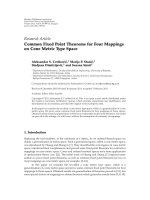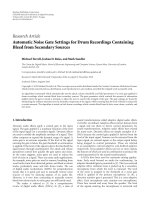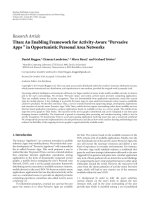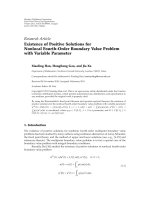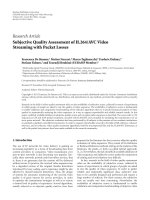Báo cáo hóa học: " Research Article Infinitely Many Solutions for a Semilinear Elliptic Equation with Sign-Changing Potential" potx
Bạn đang xem bản rút gọn của tài liệu. Xem và tải ngay bản đầy đủ của tài liệu tại đây (481.26 KB, 7 trang )
Hindawi Publishing Corporation
Boundary Value Problems
Volume 2009, Article ID 532546, 7 pages
doi:10.1155/2009/532546
Research Article
Infinitely Many Solutions for a Semilinear Elliptic
Equation with Sign-Changing Potential
Chen Yu and Li Yongqing
School of Mathematics and Computer Sciences, Fujian Normal University, Fuzhou 350007, China
Correspondence should be addressed to Chen Yu,
Received 23 March 2009; Accepted 10 June 2009
Recommended by Martin Schechter
We consider a similinear elliptic equation with sign-changing potential −Δu − V xu fx, u,
u ∈ H
1
R
N
,whereV x is a function possibly changing sign in R
N
. Under certain assumptions
on f, we prove that the equation has infinitely many solutions.
Copyright q 2009 C. Yu and L. Yongqing. This is an open access article distributed under the
Creative Commons Attribution License, which permits unrestricted use, distribution, and
reproduction in any medium, provided the original work is properly cited.
1. Introduction
In this paper, the existence of solutions of the following elliptic equation:
− Δu − V
x
u f
x, u
,u∈ H
1
R
N
P
is studied, where V x is a function possibly changing sign, f is a continuous function on
R
N
× R.
Problem P arises in various branches of applied mathematics and has been studied
extensively in recent years. For example, Rabinowitz 1 has studied the existence of a
nontrivial solution of this kind of equation on a bounded domain. Lien et al. 2 studied
the existence of positive solutions of problem P with V x ≡ λ λ is a positive constant
and fx, u|u|
p−2
u. And Grossi et al. 3 established some existence results for −Δu
λu axgu, where ax is a function possibly changing sign, gu has superlinear growth
and λ is a positive real parameter; he discussed both the cases of subcritical and critical
growth for gu and proved the existence of linking type solutions.
Cerami et al. 4 prove that the problem P has infinitely many solutions, where
ax is a regular function such that lim inf
|x|→∞
axa
∞
> 0 and some suitable decay
assumptions, fx, u|u|
p−2
u. Kryszewski and Szulkin 5 considered the existence of
2 Boundary Value Problems
a nontrivial solution of P in a situation where fx, u and V x are periodic in the x-
variable, fx, u is superlinear at u 0and±∞, and 0 lies in a spectral gap of −Δu V .
If in addition fx, u is odd in u, P has infinitely many solutions.
In 6, Zeng and Li proved existence of m − n pairs of nontrivial solutions m>n,m
and n are integers of P, under the assumption that V x is a function possibly changing
sign in R
N
and fx, u satisfies some growth conditions.
In this paper, we prove the existence of infinitely many solutions of P, under the
assumption that V x is a function possibly changing sign in R
N
and fx, u also satisfies
some growth conditions. One difficulty in considering problem P is the loss of compactness
because of R
N
; the other is that V x may change sign, which leads to difficulty in verifying
the Palais-Smale condition and applying the well-known theorem.
Notation. We use the following notations. A strip region is a domain like this: for d>
0,
Ω{x ∈ R
N
; −d<x
i
<dat least for some fixed i}. V xV
x − V
−
x, where
V
±
max{±V x, 0}. Ω
1
{x ∈ R
N
; V
−
x
/
0}, Ω
2
{x ∈ R
N
; V
−
x0}.
X is defined as the completion of DR
N
with respect to the inner product
u, v
1
:
R
N
∇u ·∇v V
−
x
uv
dx. 1.1
The functional associated with P is
I
u
:
1
2
R
N
|
∇u
|
2
V
−
x
u
2
dx −
1
2
R
N
V
x
u
2
dx −
R
N
F
x, u
dx, 1.2
for u ∈ X, where Fx, u
u
0
fx, tdt.
Our fundamental assumptions are as follows:
A
1
V
x ∈ L
N/2
R
N
,meas{x ∈ R
N
; V
x
/
0} > 0. V
−
x ∈ L
∞
R
N
, Ω
2
is a strip
region, lim
|x|→∞
V
−
xa>0inΩ
1
.
A
2
f ∈ CR
N
× R and there are constants C
1
> 0and2 <p≤ q<2
∗
such that
|fx, t|≤C
1
|t|
p−1
|t|
q−1
.
A
3
There exists α>2 such that 0 <αFx, t ≤ tfx, t for every x ∈ R
N
and t
/
0.
A
4
lim
|x|→∞
sup
|t|≤r
|fx, t|/|t|0 for every r>0.
A
5
For any t ∈ R,fx, t−fx, −t.
Here 2
∗
denotes the critical Sobolev exponent, that is, 2
∗
2N/N − 2 for N ≥ 3and
2
∗
∞ for N 1, 2.
Theorem 1.1. Under the assumptions A
1
–A
5
, P possesses infinitely many solutions on X.
Remark 1.2. It is easily seen that A
2
–A
5
hold for nonlinearities of the form fx, t
k
i1
a
i
x|t|
p
i
−2
t with 2 <p
i
< 2
∗
and for i 1, ,k, the nonnegative function a
i
x ∈
L
∞
R
N
, lim
|x|→∞
a
i
x0.
Boundary Value Problems 3
2. Preliminaries
We define the Palais-Smale denoted by PS sequences, PS-values, and PS-conditions
in X for I as follows.
Definition 2.1 cf. 7. i For c ∈ R, a sequence {u
n
} is a PS
c
-sequence in X for I if Iu
n
c ◦1 and I
u
n
◦1 strongly in X
as n →∞;
ii c ∈ R is a PS-value in X for I if there is a PS
c
-sequence in X for I;
iii I satisfies the PS
c
-condition in X if every PS
c
-sequence in X for I contains a
convergent subsequence;
iv I satisfies the PS-condition in X if for every c ∈ R, I satisfies the PS
c
-condition
in X.
Lemma 2.2 cf. 6, Lemma 2.1. Under the assumption A
1
, the inner product
u, v
1
:
R
N
∇u ·∇v V
−
x
uv
dx 2.1
is well defined; therefore the corresponding norm u
1
:
u, u
1
is well defined too, which is
equivalent to the norm u
R
N
|∇u|
2
u
2
dx
1/2
.
Lemma 2.3 cf. 8. Under the assumption that V
x ∈ L
N/2
R
N
for the eigenvalue problem
−Δu V
−
x
u μV
x
u, u ∈ E 2.2
there exists a sequence of eigenvalues μ
n
→∞such that the eigenfunction sequence ϕ
n
is an
orthonormal basis of E.
When PS
c
-condition is satisfied for all c ∈ R, there are known methods of obtaining
an unbounded sequence of critical values of ϕ see, e.g., 9.
Theorem 2.4 cf. 10, Theorem 6.5. Suppose that E is an infinite-dimensional Banach space and
suppose ϕ ∈ C
1
E, R satisfies PS-condition, ϕuϕ−u for all u, and ϕ00. Suppose
E E
−
⊕ E
,whereE
−
is finite dimensional, and assume the following conditions:
i there exist ζ>0 and >0 such that if u and u ∈ E
,thenϕu ≥ ζ;
ii for any finite-dimensional subspace W ⊂ E there exists R RW such that ϕu ≤ 0 for
u ∈ W, u≥R.
Then ϕ possesses an unbounded sequence of critical values.
3. The PS
c
-Condition
Lemma 3.1. Under the assumptions A
1
, A
2
, and A
3
, for every c ∈ R, any PS
c
-sequence is
bounded.
Proof. By the eigenvalue problem in Lemma 2.3, there exist k ∈ N such that eigenvalues are
μ
1
<μ
2
≤ μ
3
≤ ··· ≤ μ
k
≤ λ<μ
k1
≤ ··· for some λ ≥ 1; the corresponding eigenfunction
4 Boundary Value Problems
is ϕ
1
,ϕ
2
,ϕ
3
, ,ϕ
k
,ϕ
k1
, , then we denote X X
1
X
2
,withX
1
k
i1
span{ϕ
i
},X
2
X
⊥
1
,
and denote u
n
∈ X as u
n
v
n
w
n
, where v
n
∈ X
1
,w
n
∈ X
2
. It’s obvious that
R
N
|
∇u
|
2
V
−
x
u
2
− λV
x
u
2
dx ≤ 0, ∀u ∈ X
1
, 3.1
and there exist δ>0 such that
R
N
|
∇u
|
2
V
−
x
u
2
− V
x
u
2
dx ≥ δ
u
2
1
, ∀u ∈ X
2
3.2
by Lemma 2.3. For any >0, there exists C
> 0 such that |Fx, u|≥C
|u|
α
− |u|
2
from A
2
and A
3
. Choose 2 <α
<α, then
R
N
F
x, u
n
dx −
1
α
R
N
u
n
f
x, u
n
dx
≤
R
N
1 −
α
α
F
x, u
n
dx
≤
1 −
α
α
R
N
C
|
u
n
|
α
−
|
u
n
|
2
dx.
3.3
Let {u
n
} be the sequence such that Iu
n
→ c, I
u
n
→ 0. By inequality 3.2 and u
n
v
n
w
n
,v
n
∈ X
1
,w
n
∈ X
2
, and then
c 1
u
1
≥ I
u
n
−
1
α
I
u
n
,u
n
1
2
R
N
|
∇u
n
|
2
− V
x
u
2
n
dx −
R
N
F
x, u
n
dx
−
1
α
R
N
|
∇u
n
|
2
− V
x
u
2
n
dx
1
α
R
N
u
n
f
x, u
n
dx
1
2
−
1
α
R
N
|
∇w
n
|
2
− V
x
w
2
n
|
∇v
n
|
2
− V
x
v
2
n
dx
−
R
N
F
x, u
n
dx
1
α
R
N
u
n
f
x, u
n
dx
≥
1
2
−
1
α
δ
w
n
2
1
1
2
−
1
α
v
n
2
1
−
1
2
−
1
α
R
N
V
x
|
v
n
|
2
dx
α
α
− 1
R
N
C
|
u
n
|
α
−
|
u
n
|
2
dx.
3.4
Boundary Value Problems 5
Choose >0 small, then for suitable C
2
,C
3
, the above inequality becomes
c 1
u
1
≥ C
2
u
n
2
1
C
3
|
u
n
|
α
α
−
1
2
−
1
α
|
V
|
N/2
|
v
n
|
2
2
∗
. 3.5
Due to α>2, it follows that {u
n
} is bounded.
The following lemma is the same as 6, Lemma 3.2. For the completeness, we prove
it.
Lemma 3.2. Under the assumptions A
1
, A
2
, A
3
, and A
4
, I satisfies the PS-condition in X.
Proof. By Lemma 3.1, we know that any PS
c
sequence u
n
is bounded in X.Uptoa
subsequence, we may assume that u
n
uin X. In order to establish strong convergence
it suffices to show
u
n
1
−→
u
1
. 3.6
Since I
u
n
,u
n
− u→0, we infer that
0 ≤ lim sup
n →∞
u
n
2
1
−
u
2
1
lim sup
n →∞
u
n
,u
n
− u
lim sup
n →∞
R
N
f
x, u
n
u
n
− u
dx.
3.7
We restrict our attention to the case N ≥ 3, but the cases N 1, 2 can be treated similarly. Let
>0, for r ≥ 1, then
|
u
n
|
≥r
f
x, u
n
u
n
− u
dx ≤ C
4
|
u
n
|
≥r
|
u
n
|
p−1
|
u
n
− u
|
dx
≤ C
4
r
p−2
∗
|
u
n
|
≥r
|
u
n
|
2
∗
−1
|
u
n
− u
|
dx
≤ C
4
r
p−2
∗
|
u
n
|
2
∗
−1
2
∗
|
u
n
− u
|
2
∗
.
3.8
Since p<2
∗
, we may fix r large enough such that
|
u
n
|
≥r
f
x, u
n
u
n
− u
dx ≤
3
3.9
for all n. Moreover, by A
4
there exists R
1
> 0 such that
|
u
n
|
≤r
∩
|
x
|
≥R
1
f
x, u
n
u
n
− u
dx ≤
|
u
n
|
2
|
u
n
− u
|
2
sup
|
t
|
≤r,
|
x
|
≥R
1
f
x, t
|
t
|
≤
3
3.10
6 Boundary Value Problems
for all n. Finally, since u
n
→ u in L
s
B
R
1
0 for s ∈ 2, 2
∗
, we can use A
2
again to derive
|
u
n
|
≤r
∩
|
x
|
≤R
1
f
x, u
n
u
n
− u
dx ≤
3
3.11
for n large enough. Combining 3.9–3.11 we conclude that
R
N
f
x, u
n
u
n
− u
dx ≤ 3.12
for n large enough. From this and 3.7, we deduce 3.6 and complete the proof.
4. Infinitely Many Solutions
We can obtain an infinite sequence of critical values from Theorem 2.4.
Proof of Theorem 1.1. We apply Theorem 2.4 with E X, ϕ I. It is clear that I ∈ C
1
X, R is
even because of A
1
, A
2
,andA
5
. I00. By lemma 3.2, the PS-condition is satisfied.
From the proof of Lemma 3.1, we have X X
1
X
2
, where X
1
k
i1
span{ϕ
i
},X
2
X
⊥
1
.
That is E
−
X
1
,E
X
2
. We only need to check conditions i and ii.
Integrating A
2
, there is a constant C
5
> 0 such that for all x ∈ R
N
and t ∈ R,
|
F
x, t
|
≤ C
5
|
t
|
p
|
t
|
q
. 4.1
By the Sobolev embeding theorem and 3.2, we have the estimate
I
u
≥
1
2
R
N
|
∇u
|
2
V
−
x
u
2
dx −
1
2
R
N
V
x
u
2
dx − C
5
R
N
|
u
|
p
|
u
|
q
dx
≥
δ
2
u
2
1
− C
6
u
p
1
− C
7
u
q
1
4.2
for u ∈ X
2
.Letu
1
and u ∈ X
2
,
I
u
≥
δ
2
2
− C
6
p
− C
7
q
> 0 4.3
for small . Thus condition i is fulfilled with ζ δ/2
2
− C
6
p
− C
7
q
.
By A
3
, there is a constant C
8
such that |Fx, t|≥C
8
|t|
α
for every x ∈ R
N
and |t| >.
Indeed, let >0 small be given. By integration of A
3
, we have for x ∈ R
N
and |t| >,
F
x, t
≥
F
x,
α
|
t
|
α
≥ C
8
|
t
|
α
. 4.4
Boundary Value Problems 7
Let W be a finite-dimensional subspace of X. Since all norms are equivalent of W and since
I
u
≤
1
2
u
2
1
−
1
2
R
N
V
u
2
dx − C
9
u
α
α
. 4.5
Also since α>2, condition ii follows. Thus we complete the proof.
Acknowledgment
This work was supported by Key Program of NNSF of China 10830005 and NNSF of China
10471024.
References
1 P. H. Rabinowitz, Minimax Methods in Critical Point Theory with Applications to Differential Equations,
vol. 65 of CBMS Regional Conference Series in Mathematics, American Mathematical Society, Providence,
RI, USA, 1986.
2 W. C. Lien, S. Y. Tzeng, and H. C. Wang, “Existence of solutions of semilinear elliptic problems on
unbounded domains,” Differential and Integral Equations, vol. 6, no. 6, pp. 1281–1298, 1993.
3 M. Grossi, P. Magrone, and M. Matzeu, “Linking type solutions for elliptic equations with indefinite
nonlinearities up to the critical growth,” Discrete and Continuous Dynamical Systems,vol.7,no.4,pp.
703–718, 2001.
4 G. Cerami, G. Devillanova, and S. S olimini, “Infinitely many bound states for some nonlinear scalar
field equations,” Calculus of Variations and Partial Differential Equations, vol. 23, no. 2, pp. 139–168, 2005.
5 W. Kryszewski and A. Szulkin, “Generalized linking theorem with an application to a semilinear
Schr
¨
odinger equation,” Advances in Differential Equations, vol. 3, no. 3, pp. 441–472, 1998.
6 J. Zeng and Y. Li, “Existence of solutions for an elliptic equation with indefinite weight,” Nonlinear
Analysis: Theory, Methods & Applications, vol. 66, no. 11, pp. 2512–2519, 2007.
7 H C. Wang, “Palais-Smale approaches to semilinear elliptic equations in unbounded domains,”
Electronic Journal of Differential Equations. Monograph, vol. 6, pp. 1–142, 2004.
8 W. Allegretto, “Principal eigenvalues for indefinite-weight elliptic problems in
R
N
,” Proceedings of the
American Mathematical Society, vol. 116, no. 3, pp. 701–706, 1992.
9 S. Maad, “Infinitely many solutions of a symmetric semilinear elliptic equation on an unbounded
domain,” Arkiv f
¨
ur Matematik, vol. 41, no. 1, pp. 105–114, 2003.
10 M. Struwe, Variational Methods, vol. 34 of Ergebnisse der Mathematik und ihrer Grenzgebiete,Springer,
Berlin, Germany, 3rd edition, 2000.



